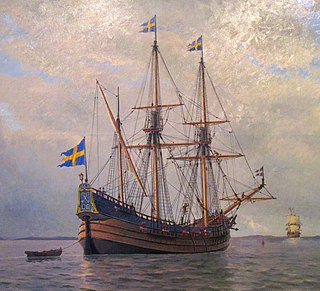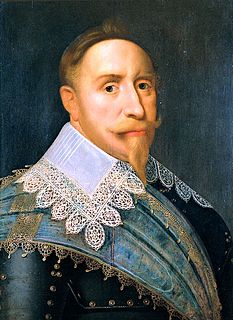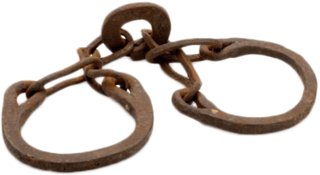 W
WThe Early Vasa era is a period that in Swedish and Finnish history lasted between 1523–1611. It began with the reconquest of Stockholm by Gustav Vasa and his men from the Danes in 1523, which was triggered by the event known as the Stockholm Bloodbath in 1520, and then was followed up by Sweden's secession from the Kalmar Union, and continued with the reign of Gustav's sons Eric XIV, John III, John's son Sigismund, and finally Gustav's youngest son Charles IX. The era was followed by a period commonly referred to as the Swedish Empire, or Stormaktstiden in Swedish, which means "Era Of Great Power".
 W
WDuring the 17th century, despite having scarcely more than 1 million inhabitants, Sweden emerged to have greater foreign influence, after winning wars against Denmark–Norway, the Holy Roman Empire, Russia, and the Commonwealth of Poland-Lithuania. Its contributions during the Thirty Years' War under Gustavus Adolphus helped determine the political, as well as the religious, balance of power in Europe.
 W
WÄlvsborg ransom was an indemnity, stipulated in the Treaty of Knäred 1613, that would redeem Älvsborg Castle from Danish military occupation of the Kalmar War. According to the treaty, the ransom was one million silver rixdollars. The ransom would be financed by a nationwide tax, which would be paid during each of the six years 1613–1618 by the entire population of Sweden. The Danes not only held Älvsborg Castle as a collateral for the ransom, but also the towns of Nya Lödöse, Old Lödöse and Gothenburg, as well as seven hundreds of Västergötland. Yet, since the return of Älvsborg was uppermost in the mind of the government, the ransom and the tax to pay for it has in history been named after this castle.
 W
WBollhuset, also called Stora Bollhuset, Bollhusteatern, and Gamla Bollhuset at various times, was the name of the first theater in Stockholm, Sweden; it was the first Swedish theater and the first real theater building in the whole of Scandinavia. The name "Bollhuset" means "The Ball House", and it was built in 1627 for ball sports and used in this way for forty years. The name Lejonkulan, however, was, in fact, the name of a different building, which was also used by the same theater in the 17th century.
 W
WCaroleans were soldiers of the Swedish kings Charles XI and Charles XII. In the late 17th and early 18th centuries, in order to compensate for its lack of manpower and resources, Sweden strove for innovative ways to make a more effective army. The tactics of Caroleans differed from those of Western European soldiers in their greater reliance upon pikes, rapiers, bayonets, and offensive strategy, which helped them to be victorious, even when greatly outnumbered, in many important Swedish battles. The Carolean army is regarded as one of the most effective military forces of their time.
 W
WEaster witches are an old Swedish legend about witches flying to Blockula on brooms on the Thursday before Easter or on the night between the Wednesday and Thursday before, and returning on Easter. In modern times children dress up as witches, old ladies or in old men's clothing and go door to door distributing greetings and often receiving treats in return.
 W
WKalmar Nyckel was a Swedish ship built by the Dutch famed for carrying Swedish settlers to North America in 1638, to establish the colony of New Sweden. The name Kalmar Nyckel comes from the Swedish city of Kalmar and nyckel meaning key in Swedish. The name was also a tribute to Kalmar Castle which was a symbol of power during the time of the Swedish Empire when Sweden was a military great power. A replica of the ship was launched at Wilmington, Delaware, in 1997.
 W
WThe Kalmar War (1611–1613) was a war between Denmark–Norway and Sweden. Though Denmark-Norway soon gained the upper hand, it was unable to defeat Sweden entirely. The Kalmar War was the last time Denmark-Norway successfully defended its dominium maris baltici against Sweden, and it also marked the increasing influence of the two countries on Baltic politics.
 W
WLejonkulan, was a historical theatre in Stockholm, Sweden, active in 1667–89. It's the historically second known theatre establishment of Stockholm, after Björngårdsteatern (1640–55).
 W
WModern Swedish is the linguistic term used for the Swedish language from the Bible translation of 1526 to the development of a common national language around 1880. The period can further be divided into Early Modern Swedish (1526–1750) and Late Modern Swedish (1750–1880).
 W
WNew Sweden was a Swedish colony along the lower reaches of the Delaware River in America from 1638 to 1655, established during the Thirty Years' War when Sweden was a great military power. New Sweden was part of Swedish colonization efforts in the Americas. Settlements were established on both sides of the Delaware Valley in the region of Delaware, New Jersey, New York, and Pennsylvania, often in places where Swedish traders had been visiting since about 1610. Fort Christina in Wilmington, Delaware was the first settlement, named after the reigning Swedish monarch. The settlers were Swedes, Finns, and a number of Dutch. New Sweden was conquered by the Dutch Republic in 1655 during the Second Northern War and incorporated into the Dutch colony of New Netherland.
 W
WThe Polish–Swedish War (1600–1611) was a continuation of struggle between Sweden and the Polish–Lithuanian Commonwealth over control of Livonia and Estonia, as well as the dispute over the Swedish throne between Charles IX of Sweden and Sigismund III of Poland.
 W
WThe Polish–Swedish War of 1621 to 1625 was a war in a long-running series of conflicts between the Polish–Lithuanian Commonwealth and the Swedish Empire. It began with a Swedish invasion of the Polish–Lithuanian fiefdom Livonia. Swedish forces succeeded in taking the city of Riga after a siege. The Commonwealth, focussed on war with the Ottoman Empire, was unable to send significant forces to stop Gustav Adolf, and signed a truce favorable to Sweden. The Commonwealth ceded Livonia north of the Dvina (Düna) river, and retained only nominal control over Riga. The new truce in Mitau was signed and lasted from November 1622 to March 1625.
 W
WJohn Robinson was an English diplomat and prelate.
 W
WThe Scanian War was a part of the Northern Wars involving the union of Denmark–Norway, Brandenburg and Sweden. It was fought from 1675 to 1679 mainly on Scanian soil, in the former Danish and Norway provinces along the border with Sweden, and in Northern Germany. While the latter battles are regarded as a theater of the Scanian war in English, Danish, Norwegian and Swedish historiography, they are seen as a separate war in German historiography, called the Swedish-Brandenburgian War.
 W
WThe Second Northern War was fought between Sweden and its adversaries the Polish–Lithuanian Commonwealth (1655–60), the Moscow Tsardom (1656–58), Brandenburg-Prussia (1657–60), the Habsburg Monarchy (1657–60) and Denmark–Norway. The Dutch Republic often intervened against Sweden in an informal trade war but was not a recognized part of the Polish–Danish alliance.
 W
WSiege of Gdov was part of the Time of Troubles and an episode of the Ingrian War.
 W
WThe Swedish slave trade mainly occurred in the early history of Sweden when the trade of thralls was one of the pillars of the Norse economy. During the raids, the Vikings often captured and enslaved militarily weaker peoples they encountered, but took the most slaves in raids of the British Isles, Ireland and Slavs in Eastern Europe. This practice lasted in the 6th through 11th centuries until formally abolished in 1335. A smaller trade of African slaves happened during the 17th and 18th centuries, around the time Swedish overseas colonies were established in North America (1638) and in Africa (1650). It remained legal until 1813.
 W
WThe Swedish Empire was a European great power that exercised territorial control over much of the Baltic region during the 17th and early 18th centuries. The beginning of the Empire is usually taken as the reign of Gustavus Adolphus, who ascended the throne in 1611, and its end as the loss of territories in 1721 following the Great Northern War.
 W
WSweden possessed overseas colonies from 1638 to 1663, in 1733 and from 1784 to 1878. Sweden possessed five colonies, four of which were short lived. The colonies spanned three continents: Africa, Asia and North America.
 W
WThe German Protestant Reformation had spread to Sweden by 1520, and resulted in the Swedish Reformation in 1527. The advent of the printing press facilitated a full translation of the Bible into Swedish in 1541. From a philological view, a new period in the development of the Swedish language called Modern Swedish was initiated with the Bible translation. It also gave power to the vernacular language.
 W
WThe Torstenson war, Hannibal controversy or Hannibal War was a short period of conflict between Sweden and Denmark–Norway from 1643 to 1645 towards the end of the Thirty Years' War. The names refer to Swedish general Lennart Torstenson and Norwegian governor-general Hannibal Sehested.
 W
WTre Kronor was a castle located in Stockholm, Sweden, on the site where Stockholm Palace is today. It is believed to have been a citadel that Birger Jarl built into a royal castle in the middle of the 13th century. The name "Tre Kronor" is believed to have been given to the castle during the reign of King Magnus IV in the middle of the 14th century.
 W
WLa troupe du Roi de Suede, or Roi de Suede for short, was a French-speaking Swedish court theater, active at the Royal Swedish court from 1699 until 1706.
 W
WSweden was a country with few witch trials compared to other countries in Europe. In Sweden, hundreds of people were executed for witchcraft prior to the last case in 1704. Most of these cases occurred during a short but intense period; the eight years between 1668 and 1676, when the witch hysteria called "The Great Noise" took place, causing a large number of witch trials in the country. It is this infamous period of intensive witch hunt that is most well-known and explored and given attention.